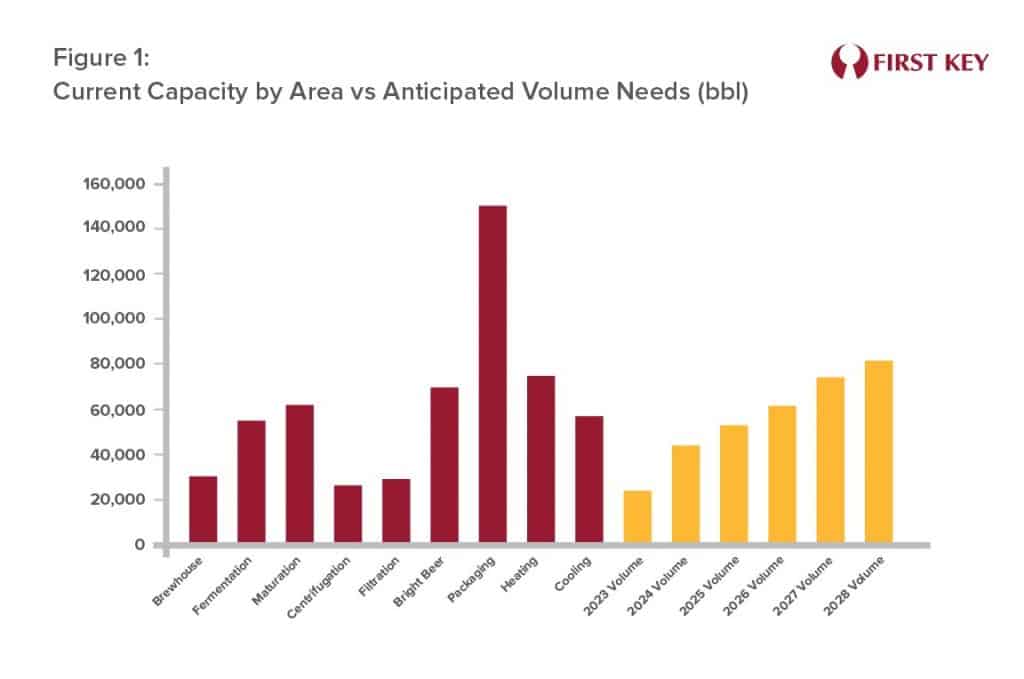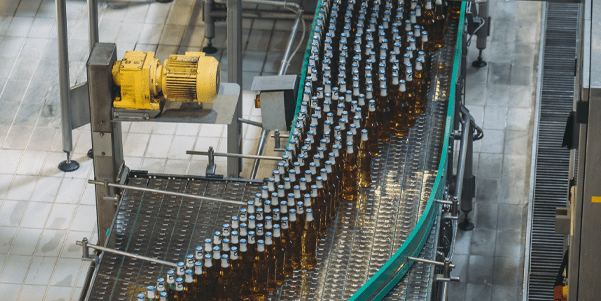A good understanding of a brewery’s current capacity and its future capacity needs is a critical component to strategic planning and long-term success. Unnecessary excess capacity is costly as underutilized capital, and at the same time, not having adequate capacity to meet anticipated volume growth results in lost sales opportunities.
Increasing capacity often requires capital spending but it is important to know where in the brewery to invest. These investments require adequate time to plan, procure, install and commission the needed equipment. While having a realistic estimate of how long it will take to add capacity has always been important, uncertainties in costing and delivery and installation timelines are particularly exacerbated these days due to global and local supply chain volatility. Often, a brewery’s capacity growth requirements cannot wait for lengthy capital projects so analysis must also be done to ensure the current system is maximizing output. This will require process improvements and non-capital spending initiatives to increase production capabilities in the short term.
The brewery’s capacity analysis must be made in the context of a multi-year plan horizon that considers anticipated volume demands. Though forecasting future demand is difficult and has its limitations, a best practice is to include a sensitivity analysis on what might constitute different scenarios (from best case to worse case). These estimates should not only be at an aggregate level, but also include the type of product (e.g., lager vs ale vs seltzer) and the type of package (can vs bottle vs keg).
Capacity decisions can impact profit margins and even the brewery’s financial viability. In order to properly plan and if possible, postpone investments, the capacity modelling initiative should include a brewery optimization study to enable the brewer to glean how much capacity can be gained by optimizing its current assets. In other words, key actions or initiatives for each area of the brewery need to be identified and prioritized to enable investment postponement and possibly accommodate unexpected volume growth.
Factors to consider when determining current capacity.
There are many factors or aspects that need to be taken into account when determining the brewery’s current capacity, including:
- What is the current peak month? Product demand is seasonal, and the highest monthly volume can sometimes account for 10% or more of the annual volume. The brewery’s capacity should be able to deliver that peak month volume.
- What volume shrinkage is expected across the process? To deliver the final packaged or kegged volume, we need to account for upstream process losses. These losses might vary depending on the beer style or recipe.
- What is the brewhouse capacity? The number of brews per day and the wort volume produced per brew need to be defined. Here again different product recipes can impact these estimates. For instance, the wort final gravity and choice of ingredients (such as malted barley vs wheat vs oats) can impact lautering rates. Lautering rates, in turn, will influence the brew cycle time and consequently the number of brews/day achievable. Similarly, specialty brews with high gravities, or recipes calling for a large hop load will also impact brewhouse cycle time and wort volumes.
- What are the capacities in fermentation and maturation? The cycle time for the fermentation and/or maturation tank will hinge on the type of beer produced, with an ale fermentation taking fewer days than a lager fermentation. Dry hopping or other cold-side specialty ingredient can add hours or days to batch processing times.
- What other products are using fermentation or maturation tankage? A brewery might be using common equipment for cider or seltzer fermentation which can take as long or longer than a beer fermentation, or using bright beer tanks (BBTs) for batching ready-to-drink beverages.
- What capabilities does the brewery have for yeast handling? How many yeast strains are in use and what are the yeast storage vessel requirements?
- What is the current centrifugation and/or filtration capacity? Here too, the product type will have an impact, as not all the products might need to be centrifuged and/or filtered. Filtration rates and cleaning cycle times need to be incorporated into the calculations.
- What is the current BBT capacity? The BBT capacity can be heavily influenced by the product portfolio complexity and by packaging scheduling. Some realistic assumptions need to be established that take into account cleaning times, purge time, fill time, and packaging volume rates.
- The packaging capacity needs to be articulated by the primary, secondary, and tertiary package types. The product portfolio can impact this capacity in a significant way. For instance, having a large number of products and suboptimal scheduling of packaging runs can result in frequent product or package format changes. These, in turn, impact line downtime, and beer losses.
- Beyond these area-specific capacities, the capacity model needs to address utilities. This includes water, CO2, heating, cooling, electricity, and wastewater handling. Likewise, CIP system capacity needs to be included in the assessment as sometimes these are shared across areas.
Figure 1 illustrates the case of a brewery with a very large surplus of packaging capacity, but is in need to address brewhouse, centrifugation and filtration capacities to meet the 2024 volume projections. Alternatives such as adding additional production shifts per month might be sufficient to close those gaps, but important decisions will be needed to properly address subsequent volume growth.

One more factor to consider is space availability. This includes the needed space not only for the brewhouse, cellaring and packaging operations, but also the warehouse space and cold storage needed. Warehouse space is very important as it may result in extra material and/or product handling. Costs increase, and quality can suffer every time the packaged product is handled, or its storage environment is changed.
Other building requirements need to be addressed in the capacity plans. For instance, there may be height restrictions or floor loading limits that can restrict the size of the tanks that can be used. Likewise, compliance with fire codes in handling flammable ingredients, such as neutral grain spirit, might trigger needs for capital expenditures or leasehold improvements.
First Key has a Capacity Model software tool that provides a holistic approach when working with clients to maximize what the current assets can deliver and plan for what is needed for future growth.
Working closely with our clients, the tool has enabled us to visually illustrate the capacity bottlenecks and expansion options available to address future capacity needs. This work, in turn, has provided a roadmap for capital planning. By tailoring the model to client-specific equipment limitations and opportunities seen through a brewery operations lens, the plan includes the key actions that need to be taken to plan for future expansion, or to postpone investments.
By Dr. Hugo Patiño – Director of Technical Services



